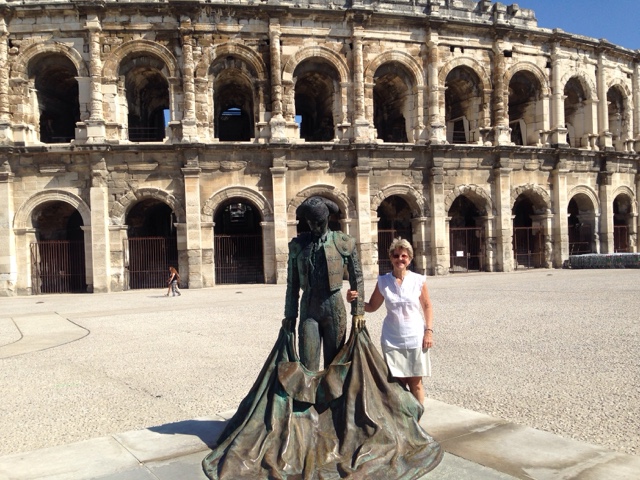June 15, 2015
Nimes and Pont du Gard
The Maison Carrée (French for "square house") in Nîmes, France, is one of the best preserved Roman temples to be found anywhere in the territory of the former Roman Empire.
The Nîmes city coat of arms is an alligator chained to a palm tree.
Veterans of the Roman legions who had served Julius Caesar in his Nile campaigns, were given plots of land to cultivate on the plain of Nîmes at the end of fifteen years of soldiering,
The Arena of Nîmes is a Roman amphitheatre in the French city of Nîmes. Built around AD 70, it was remodelled in 1863 to serve as a bullring.
Here I stand in front of the Roman Arena, two thousand years late for opening day.
Inside the Arena hallway.
Maison Carrée was built c. 16 BC, by Marcus Vipsanius Agrippa, who was also the original patron of the Pantheon in Rome. This Roman temple was dedicated c. 2-4/5 AD to his two sons, Gaius Caesar and Lucius Caesar. They were adopted heirs of Augustus who both died young.
The inscription dedicating the temple to Gaius and Lucius was removed in medieval times. However, a local scholar, Jean-François Séguier, was able to reconstruct the inscription in 1758. The text of the dedication read (in translation):
"To Gaius Caesar, son of Augustus, Consul; to Lucius Caesar, son of Augustus, Consul designate; to the princes of youth."
During the 19th century the temple slowly began to recover its original splendour. Restoration work began in 1825 and in 1869 the temple became the home of a "Roman Festival" which celebrated the glory of Rome. In the latter part of the century, all the major players of the French classical stage appeared there including Sarah Bernhardt who played "Phèdre" in 1903.
Today the Maison Carrée is just part of the neighborhood.
The Jardin de la Fontaine in Nimes France is an 18th century formal garden that features an assortment of canals, bridges and statues.
In the Jardin we visited these "Temple of Diana" Roman ruins.
My favorite photographer looks over the ruins.
School children visit the Temple of Diana.
Throughout the ancient world aqueducts heralded the greatness of Rome. A visit to the Pont du Gard proclaims the wonders of that age.
This perfectly preserved Roman aqueduct was built in about 19 B.C. as a link of a 30 mile canal that, by dropping one inch for every 350 feet, supplied nine million gallons of water per day to Nîmes, one of ancient Rome's largest cities.
Looking from the Pont du Gard down the Gardon River.
People swim, hike, and kayak here.
A first-rate museum explained the critical role fresh water played in the Roman "art of living,"
as well as how they actually created the aqueduct bridge.
This was the biggest bridge in the 30 mile system. It is exceptional because the arches are twice the width of standard aqueducts. The bridge is 160 feet high. The water made the trip in 24 hours with a drop of 40 feet.
The structure stands with no mortar except at the top where the water flowed.
There was a huge flood in 2002. The flood waters put the Pont du Gard to the test. Anxious park rangers watched as trees crashed onto ancient stones, but the arches stood strong.

















Nimes is now a place I need to visit! Hmm, a trip to France might be in my future.These photos of the bridge, temple, and arena are enticing and interesting and visually appealing.
ReplyDelete